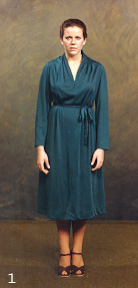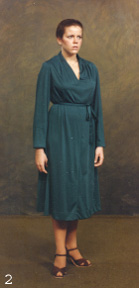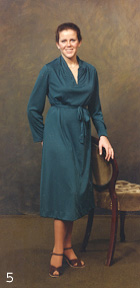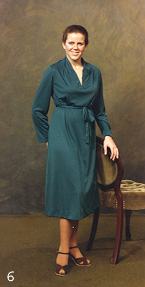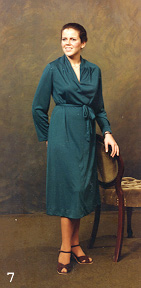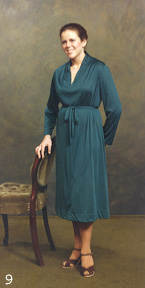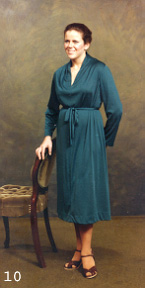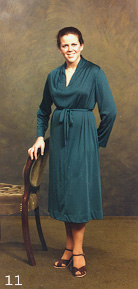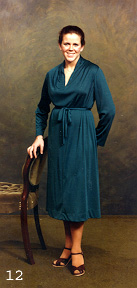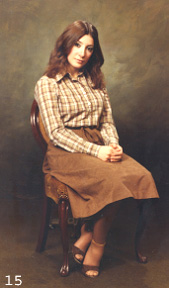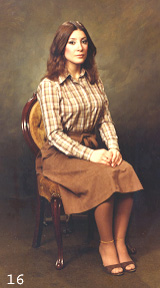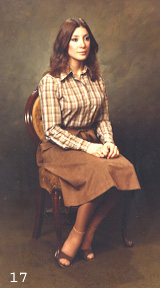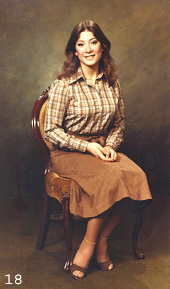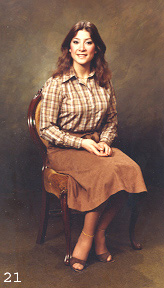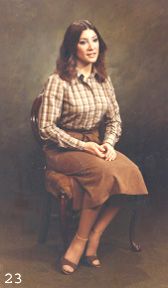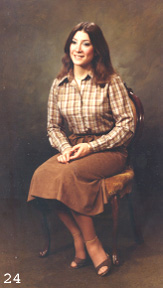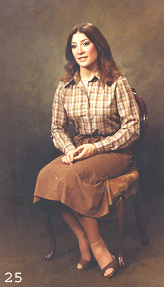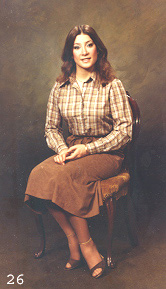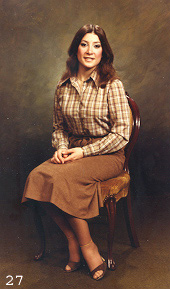|
The Zeltsman Approach to Traditional Classic Portraiture Chapter 6 Posing Women - Part One In Chapters 4 and 5, I introduced the Masculine Composition, and showed how posing men in that single composition offers a variety of head and shoulders, three-quarter length, and full-length, seated and standing poses. Men’s poses are always arranged in a Masculine Composition. Now, this Chapter and Chapter 7 will introduce you to the Feminine Composition, and show how posing women in that single composition offers a variety of head and shoulders, and seated and standing three-quarter and full length poses. And, as you will see, women are also posed in a Masculine Composition. Full Length Standing Poses Reminder: A portrait sitting session does not begin by posing the subject, but rather, by a short Facial Evaluation and Planning session, (as detailed in Chapter 3), when we decide which view or views of the subject’s face we will photograph. And then we pose the subject in a composition that supports the chosen view of the face.
In photo F-1 the young woman stands facing front, feet together, ready to be posed. The posing begins by a slight turn of the body to one side or the other. To proceed here, let’s assume that you’ve decided to show the front view of her face first, and then to turn her face toward her left shoulder to show her right two-thirds view of the face. THAT TELLS YOU that you need to turn her body to her left in this pose. The posing begins on the floor by the placement of the feet (same as the man). Ask her to keep her right foot as is, and to move her left foot back a bit behind the right foot. Then, ask her to point the left toe to the left as indicated in photo F-2 (same as the man). As you see, the body has automatically turned slightly to her left. If you studied the Posing Men Chapter, you will remember that if you want to make any adjustment to the turn of her body, you do that by asking her to turn her left foot just a bit one way or the other. Finally, you have her shift her weight on to her left hip, and bend her right knee by rolling her foot to the side as shown in Photo F-3. (NOT like a man. Like a woman).
In photo F-4 her figure is now properly arranged to show first, the front view of her face as you planned. Now, the straight lines of the arms need to be brought into diagonals (same as the men), as you see in photo F-5. Finally, the position of the head. Her head is tilted slightly towards her right (near) shoulder, and you are looking at a perfectly arranged classic Feminine Composition. The entire figure from head to toes falls into a very gentle S-curve. There is more. Look at the difference between photos F-5 and F-6. While the figure is identical in both photos, the overall effect in photo F-6 looks different. The difference is in the position of her head. It is perpendicular to her shoulder line. A Masculine Composition. The difference between the masculine and the feminine composition is in the turn and position of the head. In the masculine arrangement, the body is turned slightly (still showing the far shoulder). The head is then turned slightly to the front to show the exact front view of the face, and positioned perpendicular to the line of the shoulders. A slight turn of the head toward the subject’s far shoulder, will now show the side view of the face. An absolute: The head is never turned in opposite direction to the body in a masculine arrangement. The feminine arrangement is exactly opposite: It begins with a turn of the head toward one or the other shoulder, and the head is positioned in a slight lean toward that shoulder. (This is covered in detail next in Chapter 7)
As we discuss the posing in photo F-7, you will begin to understand how the versatility of poses offered by the pure Feminine Composition (as well as the Masculine Composition when appropriate) are used in Posing Women. The figure in photo F-7 is still in the same pose, except for the turn of the head. I remind you, that slight turn of the body to her left was planned for supporting the front view of her face and also her right two-thirds view of the face. And now, we see another choice. Turning her head toward the near shoulder without changing the pose, now also shows her left two-thirds view of the face. And note the position of the head: Masculine in photo F-7, and feminine in F-8.
Another variation of the same single posing composition: The pose in photo F-9 is an exact reversal of the pose of the preceding figure in photo F-8. The same view of the face. It takes but a minute of two to reverse the pose, starting by repositioning the feet (shown in photo), etc.. See head positions: Masculine on the left, feminine on the right.
The same pose, body turned to her right, showing front view of the face, masculine on the left, feminine on the right.
Masculine on the left, Feminine on the right. Both effective. Especially when you zoom in for a close-up head and shoulders, as in photos F-13 and F-14. Were we really discussing how to arrange just one single pose? Consider the following: Each completed pose offers a choice of a head and shoulders close-up, a three-quarter length pose, and a full length pose, all ready to be photographed and no change in the pose. There are ten completed poses among the images we discussed. That means 30 choices of poses, plus a variety of expressions! The importance of this approach is that you are not experimenting. You are comparing and evaluating available options. Every pose you arrange is complete in itself, and each pose offers a variety of applications and effects. What you choose to photograph, becomes the portrait you created. Full length Seated Poses The graceful S-curve that is the core of the Feminine Composition, is ideally suited for creating elegant seated poses of women in full length. Because the composition of a completed full length pose includes the entire figure, it offers the flexibility of bringing the camera in for close-ups, mid-distance, as well as full length portraits, without changing the basic pose in any way. The following is a step-by-step approach to arranging a woman seated, in a full length pure classic Feminine Composition. A reminder: All posing of men or women begins with the subject’s body turned a bit to one side or the other. Therefore, always position the chair for seating the subject turned a bit to one side or the other. When she sits down as the chair is facing, her body will automatically be turned in the right direction. How do you know ahead of time what is the right direction for placing the chair? That is decided ahead of time, during the short Facial Evaluation and Planning session (as detailed in Chapter 3), when you decide which facial views you will photograph.. That indicates the turn of the body, and the posing session begins by placing the chair turned in the proper direction to support the planned turn of the body.
Photo F-15 shows how, when asked to sit down, she assumed that somewhat slouching , relaxed posture, as most people will usually do. Yet, you can see how that slight turn of the chair, automatically placed her body in a desired turn, as planned. First step toward the feminine pose: She is directed to sit up, leaning away from the back of the chair, and to bring her body to its fullest height by arching the small of her back. Both feet are brought forward side by side. All illustrated in photo F-16 The next step is arranging the feet as shown in photo F-17. The front foot is brought forward, and by bending the knee, the foot is moved to the side where it is in alignment with her near right shoulder. And the back foot is moved back a bit behind the front foot, similar as in a standing pose. Note: It’s impossible to verbally direct the subject to position her feet that way. I always, when posing a woman seated in full length, after the figure was arranged, simply told her I will arrange her feet, and got down and did it. If you like this pose, you will have to do it yourself too. But do not try it on a client until you can do it. Try it first on a few friends or members of your family.
To complete this pose now, it was planned as a portrait of the front view of her face. Photo F-18 shows the two final adjustments. Her head is turned to the front to show a precise front view of her face. Her head is tilted towards the near shoulder. Her hands are moved in her lap to achieve a slight bending of the elbows and the diagonal lines of the arms. As you look at this pose, starting at the top of her head and going down to the tips of the toes, it reflects a continuous graceful S-curve. And, photos F-19 and F-20 show how perfect compositional arrangements offer additional options.
Look again at photo F-18. It is an absolutely perfect Feminine Composition. Now compare this portrait with the perfectly lovely portrait in photo F-21. Note that the pose of the figure is identical in both. But the general feeling of the total image in these two versions is quite different. The head position in photo F-21 is perpendicular to the shoulder line. A Masculine Composition. Next photo F-22 shows another option. The head is turned to he left to show the right two-thirds view of her face., and the head is in the masculine perpendicular position. Photo F-23 shows the same pose, but the head is tilted toward her near shoulder, a Feminine Composition.
Photo F-24 shows the same classic feminine composition reversed with the body turned in the opposite direction. And photo F-25 shows the head in the masculine composition.
Photos F-26 and F-27 show the same figure arrangement supporting the front view of the face, but different head positions. Clearly my approach to posing is not one of groping and trying to find an interesting pose for every subject I photograph. Instead, the elegant simplicity of my Masculine and Feminine posing arrangements, provide a wide variety of equally effective options. How do you choose? Simple! Since they are equally effective, your choice can depend entirely on your personal reactions. This concludes Part One of Posing Women. Next, Chapter 7, Posing Women - Part Two, will deal with the important topic of head and shoulders portraits. |

